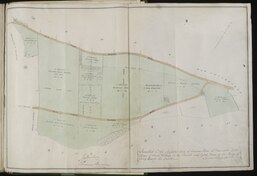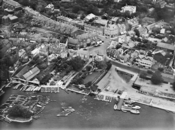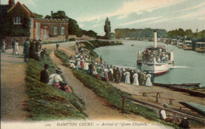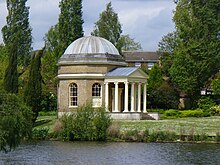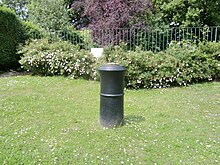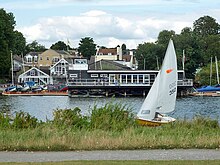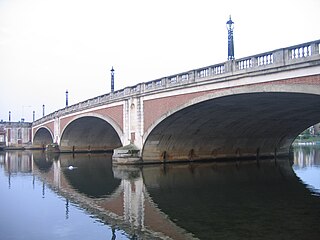| Hampton | |
|---|---|
| Suburb | |
 The River Thames at Hampton | |
Location within Greater London | |
| Area | 8.83 km2 (3.41 sq mi) |
| Population | 20,000 [1] |
| • Density | 2,265/km2 (5,870/sq mi) |
| OS grid reference | TQ135705 |
| London borough | |
| Ceremonial county | Greater London |
| Region | |
| Country | England |
| Sovereign state | United Kingdom |
| Post town | HAMPTON |
| Postcode district | TW12 |
| Dialling code | 020 |
| Police | Metropolitan |
| Fire | London |
| Ambulance | London |
| UK Parliament | |
| London Assembly | |
Hampton is a suburb of Greater London on the north bank of the River Thames, in the London Borough of Richmond upon Thames, England, and the historic county of Middlesex. Hampton is bounded by Bushy Park to the east (and to the north of St Albans Riverside facing Tagg's Island), the suburbs of Hampton Hill and Fulwell to the north, green belt to the west, [2] and the Thames to the south.
Contents
- History
- Pre-history
- Anglo-Saxon Hampton and the Norman Conquest
- Medieval Hampton and the Knights Hospitaller
- Post-medieval Hampton
- Hampton in the Modern era
- Hampton during the Great War and Interwar period
- Hampton during the Second World War
- Post-war Hampton
- Hampton and the River Thames
- Industry
- Recreation
- Islands
- River crossings
- Locks and river management
- Local Features
- Hampton Water Treatment Works
- Garrick's Villa and Temple to Shakespeare
- Hampton Court Palace
- Roy Grove cannon and the Anglo-French geodetic survey
- Other notable features
- Sport and leisure
- Football
- Rugby
- Cricket
- Sailing
- Rowing
- Canoeing
- Triathlon
- Hampton Pool
- Hampton in art, literature and other media
- Art
- Literature
- Other media
- Notable inhabitants
- Living people
- Historical figures
- Local amenities
- Education
- Churches
- Transport
- Climate
- Nearest places
- Notes and references
- Notes
- References
- Sources
- External links
- Local history
- Societies, and archived news and usergroups
Historically, the manor of Hampton included Hampton Court Palace (and Bushy Park), Hampton Hill, and Hampton Wick (which are now known collectively as "The Hamptons"). Originally settled in Saxon times, the manor was awarded to the Norman lord Walter of Saint-Valéry following the 1066 Norman Conquest, passed by his heirs to the Order of Knights of the Hospital of Saint John of Jerusalem in 1237, and acquired by Henry VIII following the 1534 Act of Supremacy. The inclosure of common land in 1811 and rapid growth of 19th-century London saw agricultural fields converted to market gardens, and later nurseries. The construction of the Hampton Water Treatment Works in the late 1850s and early 1860s, and the opening of the Shepperton Branch Line to London Waterloo in 1864, led to a steady growth in the population of Hampton, and fields in south Hampton near the station being converted to suburban housing in the late 19th century and interwar period. Refrigeration, air freight and cheaper overseas labour ultimately rendered the market gardens and nurseries uncompetitive and derelict, and after a lengthy planning process the Nurserylands estate was established in north Hampton in the 1980s.
Today Hampton is a primarily residential suburb of Greater London. The population at the 2021 Census was 27,307 (20,000 excluding Hampton Hill). [lower-alpha 1] [3]







